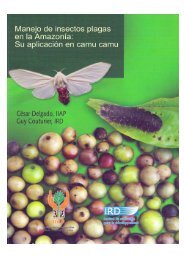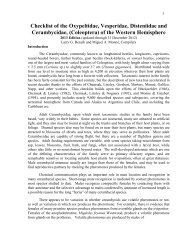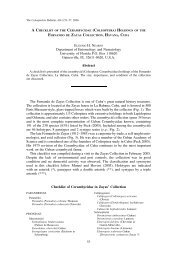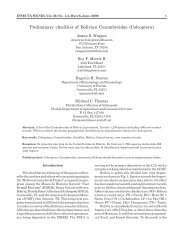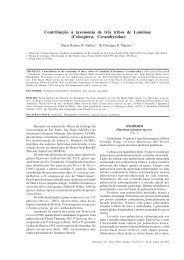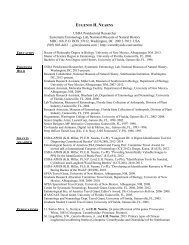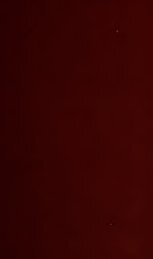Create successful ePaper yourself
Turn your PDF publications into a flip-book with our unique Google optimized e-Paper software.
LAWR.IolNCE S. DILLON <strong>AND</strong> ELIZABETH S. DILLON 79<br />
Dotum conical ; elytra strongly, coarsely, simply punctate on base,<br />
humeri conical, strongly projecting ; and procoxae unarmed in both<br />
sexes.<br />
Moderate, elongate-ovate, rather slender, subcylindrical. Head with front.<br />
elongate, Uipcring above, slightly widened below eye; genae very elongate, vertical;<br />
eye with lower lobe broadly ovate, small, about balf the height of gena; antennal<br />
tubercles prominent, subapproximate, only slightly and obtusely produced at apex<br />
in male. Pronotum transverse, conical, laterally unarmed; disk with three dis<br />
tinct tubercles. Scutellwn trall.Sverse. Elytra distinctly Iwd strongly attenuate to<br />
apices, which are separately, narrowly rounded; basal gibbosity very feeble; disk<br />
on basal third with coarse, sparse, simple punctures ; hwneri strongly projecting,<br />
conical, angle with a large, obtuse tubercle. Prostcrum simple, broad, widened<br />
posteriorly; mesosternal process short, sides nearly straight, apex deeply, bilobedly<br />
emarginate. Legs moderate in length; procoxae prominent, unarmed in both sexes,;<br />
femora gradually clavate, robust ; metatibiae in male feebly expanded; protnrai<br />
moderately dilated in male. Antennae in male one and one-third times as long<br />
as body, in female about as long as body; seape attaining apical third of pronotum,<br />
slender, clavate beyond basal third; third segment feebly bisinuate, one and one-half<br />
times as long as ,first; rest gradually shorter, eleventh subequal to tenth in male.<br />
GENOTYPE : Agaritha iolaia Dillon and Dillon, spec. no\'.<br />
Agaritha iolnia Dillon and Dillon, spec. nov.<br />
Pr..o.TE I, FIGURE 11.<br />
Superficially resembles certain of the Hypsioma, particularly<br />
H. attalia, H. opalina and H. hezia, in the slender, tapering form<br />
of the body and in coloration, but is entirely different in structure,<br />
ns can be ascertained from the generic descriptions.<br />
MALE. Elongate-ovate, rather slender, subcylindrical, clytra subconvex; hcad<br />
and pronotum piceous, elytm dull olivo-brown; above with grayish-yellow pubescence,<br />
varied with small, irregular patches of brownish pubescence, the grayishyellow<br />
on elytra fanning D:trrow, elongate patehes. Scutellum brown pubescent,<br />
with a glabrous vitta medially, narrowly vittate laterally with grayish-yellow.<br />
Beneath piceous, thinly grayish-yellow pubescent; abdomen with an nt,.tclluate<br />
vitIa of same pubescence i:tterally, middle broadly glabrous, smooth, shining, with<br />
only scattered short hairs. Legs and tarsi piceous, with thin, grayish-yellow<br />
pubescence. Antennae piceous; scape grayish-yellow pubescent, with a few small,<br />
brownish maculae and 11 large 0110 on apex; segments from third gr:ty pubescent all<br />
basal third, remainder of segments dark brown pubescent.<br />
Head above finely, densely punctate, a median impres... lille from occiput<br />
to near epistoma on front; the latter elongate, slightly widened below eyes, surface<br />
finoly, densely punctate; genae very much elongate, ·finely punct:tte; eye with<br />
lower lobe very small, broadly oval, only half the genal height; antennal tubercles<br />
aubapproximate, prominent. only very slightly :md bluntly produced at anex.



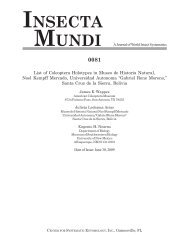
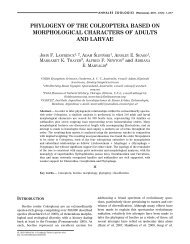


![Coleoptera. Vol. I. [Longicornia. Part I.]](https://img.yumpu.com/41202793/1/180x260/coleoptera-vol-i-longicornia-part-i.jpg?quality=85)
